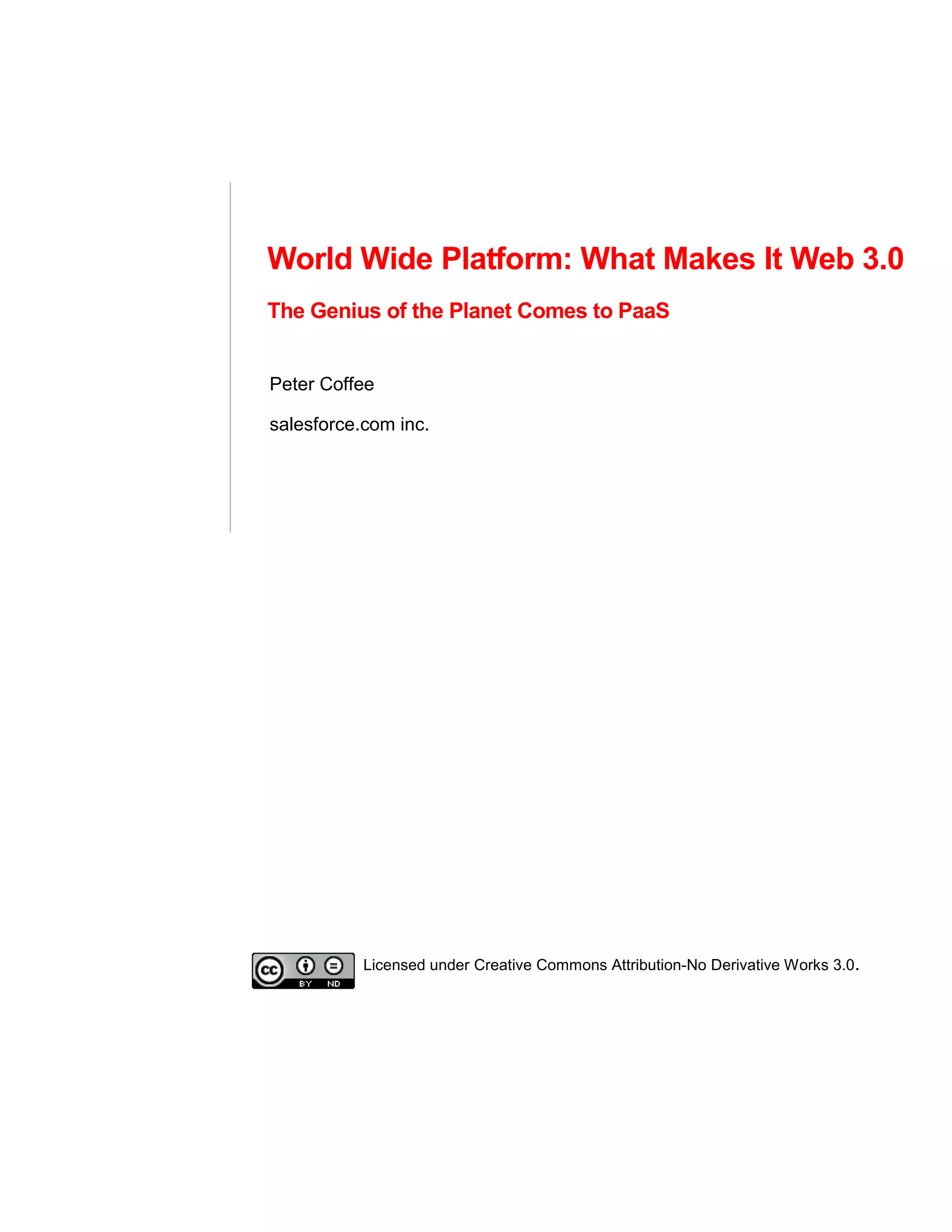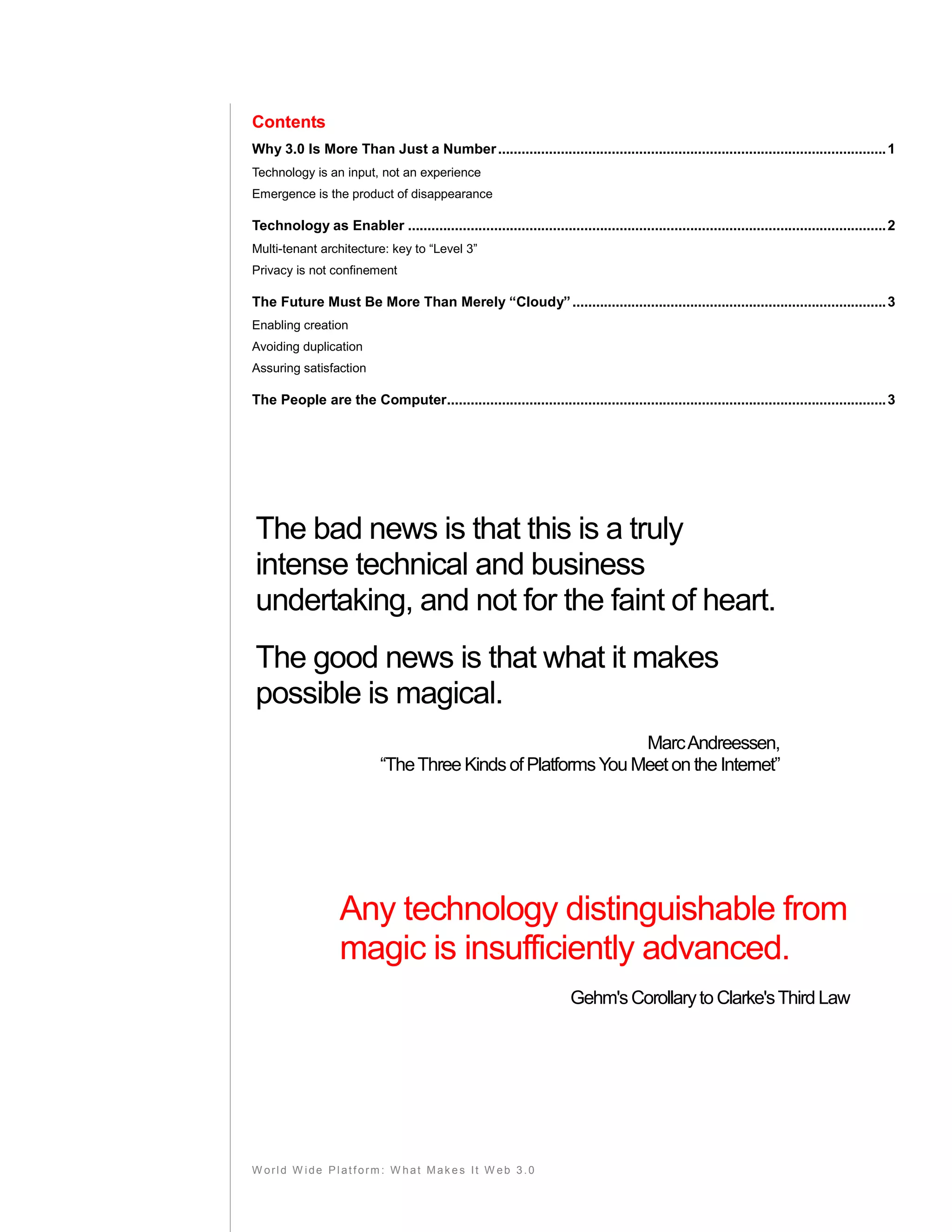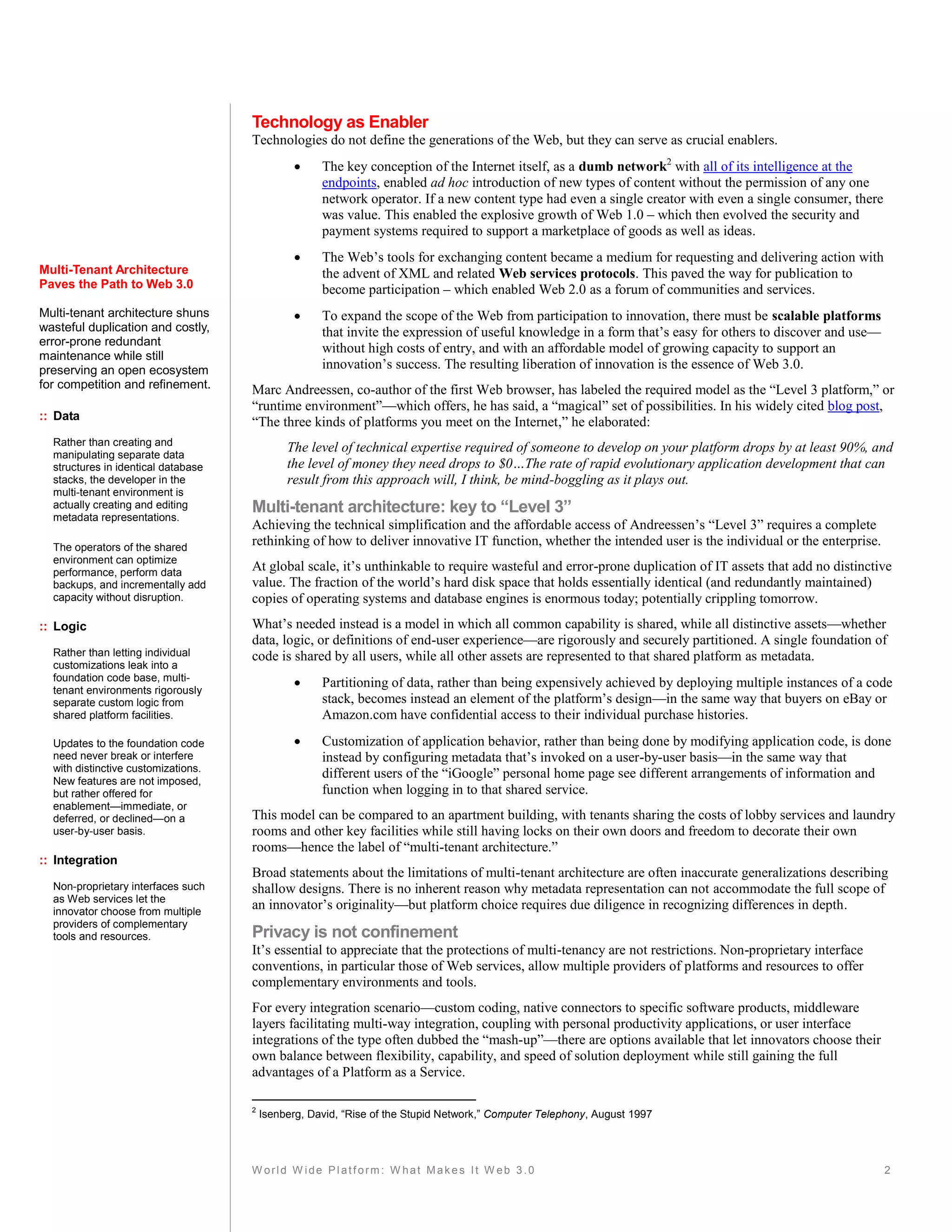The document discusses the evolution from Web 2.0 to Web 3.0, emphasizing the transformative potential of Platform as a Service (PaaS) and the need for technology to enable more creative and innovative experiences. It highlights the importance of multi-tenant architecture, which supports efficient sharing and customization while allowing users to easily create and manipulate digital content. Web 3.0 aims to redefine interactions on the internet, demanding significant functional enhancements rather than mere technical improvements.


![Why 3.0 Is More Than Just a Number
For more than two decades, the version number has been part of everyday language. It would be hard to say which
software product update brought the expression, “SomethingSomething 2.0,” into common use: perhaps it was the
March 1983 release of Microsoft MS-DOS 2.0, with its first major expansion of the power (and the complexity) of
the first ubiquitous desktop software platform.
Regardless of who gets the credit for the label, people immediately grasped the promise implied by changing the
number to the left of the decimal point – denoting a substantial increase in capability, rather than the minor
enhancements and repairs implied by a right-of-decimal “point release.” That’s why Tim O’Reilly’s coinage in
2004 of the phrase, “Web 2.0” (in connection with his subsequent series of “Web 2.0 Summit” conferences) has
Stages of Sharing been controversial ever since—and even those who accept O’Reilly’s 2.0 label may look askance at more recent
mentions of “Web 3.0.”
The generations of the Web
are best defined, not by their Following a conference in September 2007, Network World paraphrased industry analysts 1 as saying that “the
technology, but by the [Web 3.0] buzzword is really just a marketing ploy used to hype incremental improvements over the
possibilities they create and the
groundbreaking technologies that were labeled Web 2.0…”; one analyst was quoted as saying, “There are a lot of
experiences that they enable.
constituencies trying to hijack the term.”
:: Web 1.0 Technology is an input, not an experience
What others know, you can find; The error that’s made by many would-be definers of “Web 3.0” is the confusion of the tool with the function.
what others sell, you can buy Many have suggested that the original Web was all about the HTML markup language and the HTTP protocol for
linking and retrieving web pages; that Web 2.0 was all about the RSS protocol for sharing content and the Web
:: Web 2.0 services protocols (such as REST and SOAP) for sharing function.
What anyone thinks, imagines or These conceptions of Web 1.0 and Web 2.0 are too technology-centric. They lead to irrelevant argument over the
creates, everyone can discuss
role of various technology developments in defining Web 3.0. There’s a pointless war in progress among the
:: Web 3.0 proponents of richer semantic context, of sensor-centered rather than human-centered content, and of qualitative
change in experience resulting from quantitative growth in bandwidth as Web 3.0’s true hallmarks.
What anyone conceives and
implements, everyone can apply Emergence is the product of disappearance
For those who use a technology, rather than those who create and deploy it, a technical success is almost literally
The advent of the Platform as a invisible. The successful tool is the one that disappears into its function, in the phrase of philosopher Martin
Service makes it possible for Heidegger in The Origin of the Work of Art.
anyone with functional
expertise to package it, publish The success of the IBM Personal Computer was that it made the actual computer nearly invisible to the
it, and put it to work wherever user – unlike earlier hobbyist-oriented machines that exposed far more of the machine’s internal
there’s an Internet connection.
workings at a level that required the user’s attention and understanding
PaaS is the next step in The success of VisiCalc, the first packaged spreadsheet application, was that it made the products of
making our most sophisticated custom programming possible without most of the coding effort previously required for similar tasks
tools “disappear into their
function.” The initial success of Web browsers was that they enabled access to a global network while hiding the
acts and mechanisms of connection
The current and growing success of the Wiki and the blog, two of the most common user experiences
associated with “Web 2.0,” comes from letting people create and combine Web content with no need to
understand or control the mechanisms that made it happen
Web 3.0, the next major step, is
therefore best defined by what it
hides, rather than by the
technology it uses: that is, by its
success in hiding the
Web 1.0: Transact
mechanisms of creating and
sharing new function and new
behavior, going beyond the Web 2.0: Participate
sharing of static content or even
dynamic discussions of content.
Web 3.0 is best defined by the
opportunity for everyone to
Web 3.0: Innovate
program: the emergence of the
platform as a service.
1
Brodkin, Jon, “Gartner touts Web 2.0, scoffs at sequel,” networkworld.com, 21 September 2007
W orld W ide Platform: W hat Makes It W eb 3.0 1](https://image.slidesharecdn.com/worldwideplatform-130104170725-phpapp02/75/World-Wide-Platform-3-2048.jpg)

![The Future Must Be More Than Merely “Cloudy”
If the goal is for the tool to disappear into the function, it follows that a left-of-decimal uptick—such as the one
from Web 2.0 to Web 3.0—must represent a significant growth of function, and not merely an impressive
enlargement of the tool kit.
What a Web 3.0 Platform Moving the present day’s cumbersome and error-prone process of application development off of local
Must Provide infrastructure, and into an Internet “cloud computing” facility, simply is not enough to justify the uptick to 3.0.
There must be a radical simplification, not merely a relocation.
Web 3.0 is merely potential
unless it offers something Enabling creation
more, not merely something
different, than earlier A Level 3 caliber of Platform as a Service can enable a Web 3.0 transformation of experience—but only if it
incarnations of the Web. liberates creative energy. The platform must be open to the definition of data models that map closely to an
expert’s understanding of a problem or a task. It must have powerful notations for expressing knowledge in the
:: Creation form of reliable and powerful logic. It must give the expert a blank canvas on which to draw a user interface that
makes the power of knowledge and data readily discoverable by the person with a problem to be solved. The
Web 3.0 must make it radically Force.com platform from salesforce.com meets these needs with its database capabilities, workflow and Apex
easier to create new capability,
and not merely move today’s
Code tools, and Visualforce user interface technology that enables astonishingly rapid design and refinement.
cumbersome process of
development into the cloud Avoiding duplication
The tyranny of “good enough” will cripple the potential of Web 3.0 if a Platform as a Service requires redundant
:: Leverage re-implementation of systems that are already working. The Force.com platform shuns wasteful duplication by
offering an extensive variety of integration points, ranging from custom code interfaces to packaged integration
Existing IT assets, and the best
of the emerging ecosystem of appliances; the developer can gain full leverage from legacy IT assets or from the best of the emerging ecosystem
new cloud-computing resources, of complementary Web services or from storage, computational, or other bulk resources available in the cloud.
must be accessible resources for
the Web 3.0 developer Assuring satisfaction
Widespread adoption of the Web has generated high expectations (and rapidly rising demands) for availability,
:: Assurance security, confidentiality and data integrity. Web 3.0 offerings can not expect a favorable reception if they offer the
Platforms as a Service must be “new” at the expense of the “now.” The applications built with the creative vigor and entrepreneurial spirit of Web
highly available, certifiably 3.0 must be born, so to speak, already grown up: that is, with the same robustness as existing Web offerings. The
secure, reliably confidential, and Force.com platform gives creative and entrepreneurial developers the assurance of proven reliability, auditable
robust in capacity and
performance
security, and enterprise-scale robustness as a foundation for what they bring into the world.
The Force.com platform from
The People are the Computer
salesforce.com is ready to If Tim O’Reilly gets the credit for “Web 2.0,” then Sun Microsystems’ John Gage must get the credit for the
serve—and to liberate the coinage “The Network is the Computer”—but Gage, like O’Reilly, has been overtaken. The collaboration in
planet-wide wave of creative content of Web 2.0 has been succeeded by the liberation of creativity of Web 3.0 and the Platform as a Service.
output that will make “Web 3.0”
a label worth defining The appeal of PaaS is internationally acknowledged. In June 2008, industry analyst Fredric Paul asserted3 that
PaaS resources “make leading-edge technology available to everyone, including consumers, often at a far lower
cost than businesses pay for similar or inferior services.” Another industry observer, in Bangalore, reported in the
same month4 that PaaS is “driving a change on how future application software will be and should be developed,
installed, delivered, and managed” and that it is being considered by “every major [developer], in any space.”
When the burdens of hardware and code disappeared into mass-market technology, the network added the value;
as the physical network disappears into the abstractions of the Web, we can rediscover that it is people who are the
true source of value. Web 3.0 brings global talent to PaaS.
3
Paul, Fredric, “SMBs Will Rise To Cloud Computing,” informationweek.com, 21 June 2008
4
Akhouri, Priyanka, “SaaS Healing Business Pain Points, Say ISVs,” cxotoday.com/India, 27 June 2008](https://image.slidesharecdn.com/worldwideplatform-130104170725-phpapp02/75/World-Wide-Platform-5-2048.jpg)